
The Battle of Blenheim fought on 13 August [O.S. 2 August] 1704, was a major battle of the War of the Spanish Succession. The overwhelming Allied victory ensured the safety of Vienna from the Franco-Bavarian army, thus preventing the collapse of the reconstituted Grand Alliance.
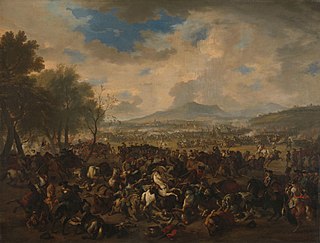
The Battle of Ramillies, fought on 23 May 1706, was a battle of the War of the Spanish Succession. For the Grand Alliance – Austria, England, and the Dutch Republic – the battle had followed an indecisive campaign against the Bourbon armies of King Louis XIV of France in 1705. Although the Allies had captured Barcelona that year, they had been forced to abandon their campaign on the Moselle, had stalled in the Spanish Netherlands and suffered defeat in northern Italy. Yet despite his opponents' setbacks Louis XIV wanted peace, but on reasonable terms. Because of this, as well as to maintain their momentum, the French and their allies took the offensive in 1706.
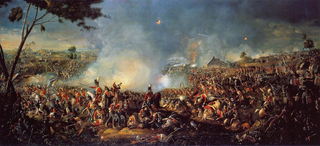
The Battle of Waterloo was fought on Sunday 18 June 1815, near Waterloo, marking the end of the Napoleonic Wars. A French army under the command of Napoleon was defeated by two armies of the Seventh Coalition. One of these was a British-led force with units from the United Kingdom, the Netherlands, Hanover, Brunswick, and Nassau, under the command of the Duke of Wellington. The other comprised three corps of the Prussian army under Field Marshal Blücher. The battle was known contemporarily as the Battle of Mont Saint-Jean in France or La Belle Alliance in Prussia.
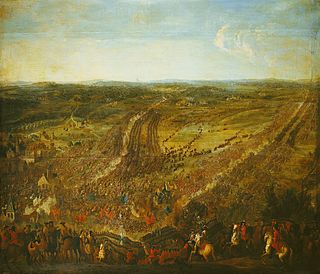
The Battle of Fleurus, fought on 1 July 1690 near Fleurus, then part of the Spanish Netherlands, now in modern Belgium, was a major engagement of the Nine Years' War. A French army led by Luxembourg defeated an Allied force under Waldeck.
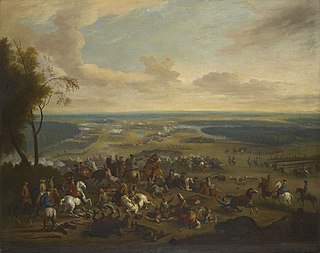
The Battle of Malplaquet took place on 11 September 1709 during the War of the Spanish Succession, near Taisnières-sur-Hon in modern France, then part of the Spanish Netherlands. A French army of around 75,000 men, commanded by the Duke of Villars, engaged a Grand Alliance force of 86,000 under the Duke of Marlborough. In one of the bloodiest battles of the 18th century, the Allies won a narrow victory, but suffered heavy casualties.
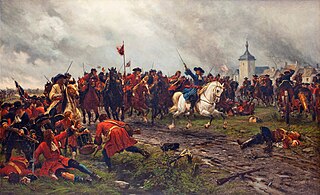
The Battle of Landen, took place on 29 July 1693, during the Nine Years' War near Landen, then in the Spanish Netherlands, now part of Belgium. A French army under Marshal Luxembourg defeated an Allied force led by William III.

The Battle of Oudenarde, also known as the Battle of Oudenaarde, was a major engagement of the War of the Spanish Succession, pitting a Grand Alliance force consisting of eighty thousand men under the command of the Duke of Marlborough and Prince Eugene of Savoy against a French force of eighty-five thousand men under the command of the Duc de Bourgogne and the Duc de Vendôme, the battle resulting in a great victory for the Grand Alliance. The battle was fought near the city of Oudenaarde, at the time part of the Spanish Netherlands, on 11 July 1708. With this victory, the Grand Alliance ensured the fall of various French territories, giving them a significant strategic and tactical advantage during this stage of the war. The battle was fought in the later years of the war, a conflict that had come about as a result of English, Dutch and Habsburg apprehension at the possibility of a Bourbon succeeding the deceased King of Spain, Charles II, and combining their two nations and empires into one.

The Battle of Barrosa was part of an unsuccessful manoeuvre by an Anglo-Iberian force to break the French siege of Cádiz during the Peninsular War. During the battle, a single British division defeated two French divisions and captured a regimental eagle.

The Battle of Cassel, also known as the Battle of Peene, took place on 11 April 1677 during the Franco-Dutch War, near Cassel, 15 km (9 mi) west of Saint-Omer. A French army commanded by the duc de Luxembourg defeated a combined Dutch–Spanish force under William of Orange.

The Battle of Saint-Denis was the last major action of the Franco-Dutch War (1672-78). It took place on 14 August 1678, four days after Louis XIV of France had agreed the Treaty of Nijmegen with the Dutch Republic, but before he finalised terms with Spain. The battle was initiated by the Dutch and Spanish forces to prevent the French capturing the Spanish-held town of Mons, then on the border between France and the Spanish Netherlands. The result was disputed, as both sides claimed victory.

The 1695 Siege of Namur or Second Siege of Namur took place during the Nine Years' War between 2 July and 4 September 1695. Its capture by the French in the 1692 siege and recapture by the Grand Alliance in 1695 are often viewed as the defining events of the war; the second siege is considered to be William III's most significant military success during the war.

At the Battle of Elixheim, 18 July 1705, also known as the Passage of the Lines of Brabant during the War of the Spanish Succession, the Anglo-Dutch forces of the Grand Alliance, under the Duke of Marlborough, successfully broke through the French Lines of Brabant. These lines were an arc of defensive fieldworks stretching in a seventy-mile arc from Antwerp to Namur. Although the Allies were unable to bring about a decisive battle, the breaking and subsequent razing of the lines would prove critical to the Allied victory at Ramillies the next year.

The Battle of Ekeren, which took place on 30 June 1703, was a battle of the War of the Spanish Succession. A Bourbon army of around 24,000 men, conisting of troops from France, Spain and Cologne, surrounded a smaller Dutch force of 12,000 men, which however managed to break out and retire to safety.
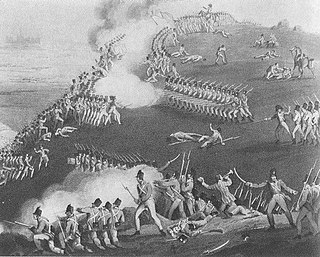
In the Battle of Castalla on 13 April 1813, an Anglo-Spanish-Sicilian force commanded by Lieutenant General Sir John Murray fought Marshal Louis Gabriel Suchet's French Army of Valencia and Aragon. Murray's troops successfully repelled a series of French attacks on their hilltop position, causing Suchet to retreat. The action took place during the Peninsular War, part of the Napoleonic Wars. Castalla is located 35 kilometers north-northwest of Alicante, Spain.

The Battle of Speyerbach took place on 15 November 1703 during the War of the Spanish Succession, near Speyer in the modern German state of Rhineland-Palatinate. A French army commanded by Camille de Tallard defeated an Allied force under Frederick of Hesse.

The Battle of El Bodón was a successful rearguard action fought on 25 September 1811 by elements of the Anglo-Portuguese army against waves of French cavalry, supported by a division of infantry of the French army during the Peninsular War.

The siege of Schenkenschans was a siege that took place from 28 April to 2 May 1599 as part of the Eighty Years' War and the Anglo–Spanish War. Schenkenschans was garrisoned largely by English troops and was besieged by a Spanish force led by Francisco de Mendoza. The siege failed with losses and the Spanish were forced to retreat when a relief force arrived.

Claude Frederic t'Serclaes, Count of Tilly, was a soldier and later general in the Dutch States Army. In the Dutch army he took part in the Franco-Dutch War, Nine Years' War and the War of the Spanish Succession and became its supreme commander in 1708.
Frederik Sirtema van Grovestins was a Frisian officer in the Dutch States Army. He advanced through the various ranks in the army, from captain and cavalry captain (Ritmeester) to lieutenant-general of cavalry. Furthermore, he became general-quarter-master of the army and colonel of a regiment on foot at the repartition of Zeeland. In 1712 he became governor of Bouchain, in 1718 of Bergen-op-Zoom. He was an outstanding cavalry commander who played an important role in various campaigns and battles. He also was an excellent military theorist, who stressed to the cavalry of the Allies to seek their strength in combat with the bladed weapon, something that possibly influenced Friedrich Wilhelm von Seydlitz when he developed the Prussian cavalry later in the 18th century.

The Battle of Stekene took place on 27 June 1703, during the War of the Spanish Succession, when a Dutch force of 7,000 men, under Karel Willem Sparre, attacked the Franco-Spanish defensive that ran from Ostend to Antwerp. The lines at Stekene were defended by 2,500 French soldiers under La Mothe and 1,500 to 6,000 local Flemish farmers. After a 3 hour long battle the French abandoned their posts, which allowed the Dutch too capture the defensive works. The Dutch then attacked and captured the village of Stekene itself where the local farmers fiercely resisted.






















